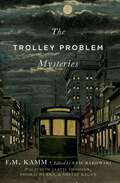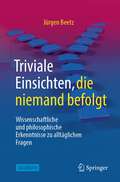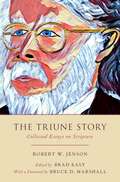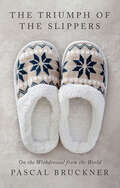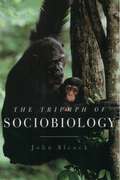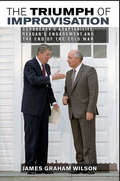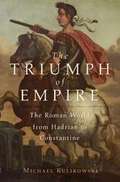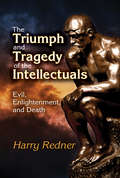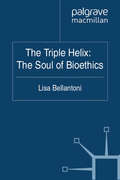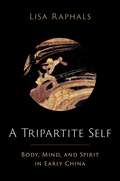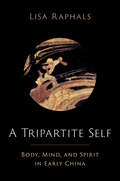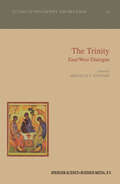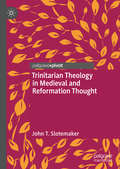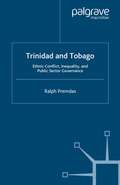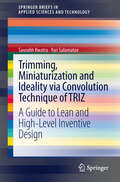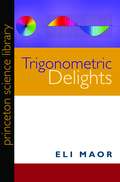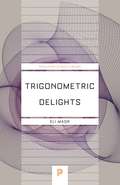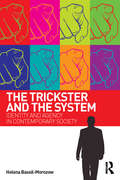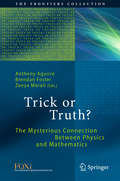- Table View
- List View
The Trolley Problem Mysteries (The Berkeley Tanner Lectures)
by F.M. KammA rigorous treatment of a thought experiment that has become notorious within and outside of philosophy - The Trolley Problem - by one of the most influential moral philosophers alive today Suppose you can stop a trolley from killing five people, but only by turning it onto a side track where it will kill one. May you turn the trolley? What if the only way to rescue the five is to topple a bystander in front of the trolley so that his body stops it but he dies? May you use a device to stop the trolley that will kill a bystander as a side effect? The "Trolley Problem" challenges us to explain and justify our different intuitive judgments about these and related cases and has spawned a huge literature. F.M. Kamm's 2013 Tanner Lectures present some of her views on this notorious moral conundrum. After providing a brief history of changing views of what the problem is about and attempts to solve it, she focuses on two prominent issues: Does who turns the trolley and how the harm is shifted affect the moral permissibility of acting? The answers to these questions lead to general proposals about when we may and may not harm some to help others. Three distinguished philosophers - Judith Jarvis Thomson (one of the originators of the trolley problem), Thomas Hurka, and Shelly Kagan - then comment on Kamm's proposals. She responds to each comment at length, providing an exceptionally rich elaboration and defense of her views. The Trolley Problem Mysteries is an invaluable resource not only to philosophers concerned about the Trolley Problem, but to anyone worried about how we ought to act when we can lessen harm to some by harming others and how we can reach a decision about the question.
The Trolley Problem Mysteries (The Berkeley Tanner Lectures)
by F.M. KammA rigorous treatment of a thought experiment that has become notorious within and outside of philosophy - The Trolley Problem - by one of the most influential moral philosophers alive today Suppose you can stop a trolley from killing five people, but only by turning it onto a side track where it will kill one. May you turn the trolley? What if the only way to rescue the five is to topple a bystander in front of the trolley so that his body stops it but he dies? May you use a device to stop the trolley that will kill a bystander as a side effect? The "Trolley Problem" challenges us to explain and justify our different intuitive judgments about these and related cases and has spawned a huge literature. F.M. Kamm's 2013 Tanner Lectures present some of her views on this notorious moral conundrum. After providing a brief history of changing views of what the problem is about and attempts to solve it, she focuses on two prominent issues: Does who turns the trolley and how the harm is shifted affect the moral permissibility of acting? The answers to these questions lead to general proposals about when we may and may not harm some to help others. Three distinguished philosophers - Judith Jarvis Thomson (one of the originators of the trolley problem), Thomas Hurka, and Shelly Kagan - then comment on Kamm's proposals. She responds to each comment at length, providing an exceptionally rich elaboration and defense of her views. The Trolley Problem Mysteries is an invaluable resource not only to philosophers concerned about the Trolley Problem, but to anyone worried about how we ought to act when we can lessen harm to some by harming others and how we can reach a decision about the question.
Triviale Einsichten, die niemand befolgt: Wissenschaftliche und philosophische Erkenntnisse zu alltäglichen Fragen
by Jürgen BeetzWarum ist ein „Wirtschaftsweiser“ für Mindestlöhne und ein anderer dagegen? Wieso verfangen wir uns in ergebnislosen Diskussionen oder albernen Paradoxien, fallen auf die „Spielchen“ unserer Mitmenschen herein, verkennen Ursache und Wirkung, verwechseln Zufall und Vorbestimmung? Weshalb denken wir so und handeln anders? Sagen wir, was wir meinen oder meinen wir viel mehr oder etwas ganz anderes, als wir sagen? Wieso entstehen neue Systeme mit meist unerwarteten Eigenschaften „von selbst“? Wie entsteht eine neue Qualität durch eine veränderte Quantität? Dieses Buch zeigt, dass Philosophie, die „Liebe zur Weisheit“, auch im Alltag viele Probleme lösen und Handlungsanweisungen liefern kann. Dabei sind es oft „triviale Einsichten“, die uns einen Schritt voran bringen: Erkenntnisse, die wir schon längst haben oder durch ein wenig Nachdenken erlangen könnten, die wir aber einfach nicht beherzigen – aus vielfältigen Gründen, die hier ausführlich untersucht werden, mit dem Ziel, sie zu überwinden. Hier gehen Hirnforschung, Naturwissenschaften, Psychologie und Philosophie nebst einer Prise (Selbst-)Ironie eine interessante und amüsante Verbindung ein. Uns begegnen auf dieser Exkursion Paradoxien, die menschliche Evolution, zyklische Prozesse und seltsame Schleifen, Wahrnehmungstäuschungen, vernetzte Systeme und Regelkreise – schließlich das Chaos und die „objektive“ Wahrheit. Die Leser lernen, Querverbindungen und Zusammenhänge zu erkennen, die sie bisher nicht gesehen haben. Einfache Erkenntnisse werden erneut ins Gedächtnis gerufen. Wir entdecken offensichtliche Vorteile beim Gebrauch des Verstandes und vermeiden die kleinen aber tückischen Fallen des Alltags: fruchtlose Schwarz-/Weiß-Diskussionen, verborgene Zwickmühlen innerer Widersprüche, kostspieligen Aberglauben oder schädliche Psycho-Spiele. Also lautet die Devise: „Benutze deinen Verstand!“
TRIUNE STORY C: Collected Essays on Scripture
by Robert W. JensonAt the time of his death in the autumn of 2017, Robert W. Jenson was arguably America's foremost theologian. Over the course of a career spanning more than five decades, much of Jenson's thought was dedicated to the theological description of how Scripture should be read-what has come to be called theological interpretation. In this rapidly expanding field of scholarship, Jenson has had an inordinate impact. Despite its importance, study of Jenson's theology of scriptural interpretation has lagged, due in large part to the longevity of his career and volume of his output. In this book, all of Jenson's writings on Scripture and its interpretation have been collected for the first time. Here readers will be able to see the evolution of Jenson's thought on this topic, as well as the scope and intensity of his late-period engagement with it. Where other twentieth-century thinkers rely on non-theological, secular methods of scriptural investigation, Jenson is willing to let go of "respectability" for the sake of a truly Christian theological interpretation. The result is a genuinely free, intellectually invigorating exercise in reading and theory from one of the greatest theologians in the last century.
The Triune Story: Collected Essays on Scripture
by Robert W. JensonAt the time of his death in the autumn of 2017, Robert W. Jenson was arguably America's foremost theologian. Over the course of a career spanning more than five decades, much of Jenson's thought was dedicated to the theological description of how Scripture should be read-what has come to be called theological interpretation. In this rapidly expanding field of scholarship, Jenson has had an inordinate impact. Despite its importance, study of Jenson's theology of scriptural interpretation has lagged, due in large part to the longevity of his career and volume of his output. In this book, all of Jenson's writings on Scripture and its interpretation have been collected for the first time. Here readers will be able to see the evolution of Jenson's thought on this topic, as well as the scope and intensity of his late-period engagement with it. Where other twentieth-century thinkers rely on non-theological, secular methods of scriptural investigation, Jenson is willing to let go of "respectability" for the sake of a truly Christian theological interpretation. The result is a genuinely free, intellectually invigorating exercise in reading and theory from one of the greatest theologians in the last century.
The Triumph of the Slippers: On the Withdrawal from the World
by Pascal BrucknerSince the beginning of the 21st century, global warming, terrorism, the pandemic and now the war in Ukraine have created a widespread feeling that the world is an increasingly dangerous place. In response to this situation, it is understandable that many people are inclined to retreat to the safety of their home – the last refuge and safeguard against the savagery of the outside world. But the home is not just a shelter: it is a space that supplants and replaces the world, a wired cocoon that gradually renders any journey to the outside world superfluous. From our couch, we can enjoy remotely the pleasures once offered by the cinema, the theatre and the café. Everything, from food to love to art, can be delivered to your door. Armed with a smartphone and a Netflix account, why would anyone risk life and limb to venture out to the cinema? Compulsory confinement, the nightmare of the pandemic years, seems to have been replaced by voluntary self-confinement. Fleeing from the cities, working remotely, relinquishing travel and tourism, we risk becoming reclusive creatures that cower at the slightest tremor. In this witty and spirited book, Pascal Bruckner takes aim at today’s voluntary seclusionism and the self-inflicted atrophy that comes with it, tracing its philosophical contours and historical roots. It is no longer the tyranny of lockdowns that threatens us but rather the tyranny of the sofa: will the slipper and the dressing gown be the new symbols of tomorrow's world?
The Triumph of Sociobiology
by John AlcockIn The Triumph of Sociobiology, John Alcock reviews the controversy that has surrounded evolutionary studies of human social behavior following the 1975 publication of E.O. Wilson's classic, Sociobiology, The New Synthesis. Denounced vehemently as an "ideology" that has justified social evils and inequalities, sociobiology has survived the assault. Twenty-five years after the field was named by Wilson, the approach he championed has successfully demonstrated its value in the study of animal behavior, including the behavior of our own species. Yet, misconceptions remain--to our disadvantage. In this straight-forward, objective approach to the sociobiology debate, noted animal behaviorist John Alcock illuminates how sociobiologists study behavior in all species. He confronts the chief scientific and ideological objections head on, with a compelling analysis of case histories that involve such topics as sexual jealousy, beauty, gender difference, parent-offspring relations, and rape. In so doing, he shows that sociobiology provides the most satisfactory scientific analysis of social behavior available today. Alcock challenges the notion that sociobiology depends on genetic determinism while showing the shortcoming of competing approaches that rely on cultural or environmental determinism. He also presents the practical applications of sociobiology and the progress sociobiological research has made in the search for a more complete understanding of human activities. His reminder that "natural" behavior is not "moral" behavior should quiet opponents fearing misapplication of evolutionary theory to our species. The key misconceptions about this evolutionary field are dissected one by one as the author shows why sociobiologists have had so much success in explaining the puzzling and fascinating social behavior of nonhuman animals and humans alike.
The Triumph of Improvisation: Gorbachev's Adaptability, Reagan's Engagement, and the End of the Cold War
by James WilsonIn The Triumph of Improvisation, James Graham Wilson takes a long view of the end of the Cold War, from the Soviet invasion of Afghanistan in December 1979 to Operation Desert Storm in January 1991. Drawing on deep archival research and recently declassified papers, Wilson argues that adaptation, improvisation, and engagement by individuals in positions of power ended the specter of a nuclear holocaust. Amid ambivalence and uncertainty, Mikhail Gorbachev, Ronald Reagan, George Shultz, and George H. W. Bush—and a host of other actors—engaged with adversaries and adapted to a rapidly changing international environment and information age in which global capitalism recovered as command economies failed. Eschewing the notion of a coherent grand strategy to end the Cold War, Wilson paints a vivid portrait of how leaders made choices; some made poor choices while others reacted prudently, imaginatively, and courageously to events they did not foresee. A book about the burdens of responsibility, the obstacles of domestic politics, and the human qualities of leadership, The Triumph of Improvisation concludes with a chapter describing how George H. W. Bush oversaw the construction of a new configuration of power after the fall of the Berlin Wall, one that resolved the fundamental components of the Cold War on Washington’s terms.
The Triumph of Empire: The Roman World From Hadrian To Constantine (History Of The Ancient World Ser. #1)
by Michael KulikowskiMichael Kulikowski takes readers into the political heart of imperial Rome, beginning with the reign of Hadrian, who visited the farthest reaches of his domain and created stable frontiers, to the decades after Constantine the Great, who overhauled the government, introduced a new state religion, and founded a second Rome.
The Triumph of Empire: The Roman World From Hadrian To Constantine (History Of The Ancient World Ser. #1)
by Michael KulikowskiMichael Kulikowski takes readers into the political heart of imperial Rome, beginning with the reign of Hadrian, who visited the farthest reaches of his domain and created stable frontiers, to the decades after Constantine the Great, who overhauled the government, introduced a new state religion, and founded a second Rome.
The Triumph and Tragedy of the Intellectuals: Evil, Enlightenment, and Death
by Harry RednerThis fourth instalment of Harry Redner's tetralogy on the history of civilization argues that intellectuals have a brilliant past, a dubious present, and possibly no future. He contends that the philosophers of the seventeenth century laid the ground for the intellectuals of the eighteenth century, the Age of Enlightenment. They, in turn, promoted a fundamental transformation of human consciousness: they literally intellectualized the world. The outcome was the disenchantment of the world in all its cultural dimensions: in art, religion, ethics, politics, and philosophy.In this fascinating study, Redner demonstrates how secularization took the sting out of both the dread and promise of an afterlife and intellectuals learned to die without the hope of immortality popularized by philosophy and religion. Ultimately, they produced the ideologies that generated the totalitarian regimes of the twentieth century, which subsequently exterminated these intellectuals through mass murder on a scale never before experienced. The book traces the sources of this fatal entanglement and goes on to examine the contemporary condition of intellectuals in America and the world.Wherein lies the future of the intellectuals? Redner suggest that in the present state of globalization, dominated by technocrats, experts, and professionals, their fate remains uncertain.
The Triumph and Tragedy of the Intellectuals: Evil, Enlightenment, and Death
by Harry RednerThis fourth instalment of Harry Redner's tetralogy on the history of civilization argues that intellectuals have a brilliant past, a dubious present, and possibly no future. He contends that the philosophers of the seventeenth century laid the ground for the intellectuals of the eighteenth century, the Age of Enlightenment. They, in turn, promoted a fundamental transformation of human consciousness: they literally intellectualized the world. The outcome was the disenchantment of the world in all its cultural dimensions: in art, religion, ethics, politics, and philosophy.In this fascinating study, Redner demonstrates how secularization took the sting out of both the dread and promise of an afterlife and intellectuals learned to die without the hope of immortality popularized by philosophy and religion. Ultimately, they produced the ideologies that generated the totalitarian regimes of the twentieth century, which subsequently exterminated these intellectuals through mass murder on a scale never before experienced. The book traces the sources of this fatal entanglement and goes on to examine the contemporary condition of intellectuals in America and the world.Wherein lies the future of the intellectuals? Redner suggest that in the present state of globalization, dominated by technocrats, experts, and professionals, their fate remains uncertain.
The Triple Helix: The Soul Of Bioethics
by L. BellantoniLisa Bellantoni argues that contemporary bioethics divides into two logically incommensurable positions: a cult of rights, which identifies the worth of human life with our autonomy, and a cult of life, which identifies human worth with the possession of a soul, and thereby, of human dignity.
A Tripartite Self: Mind, Body, and Spirit in Early China
by Lisa RaphalsChinese philosophy has long recognized the importance of the body and emotions in extensive and diverse self-cultivation traditions. Philosophical debates about the relationship between mind and body are often described in terms of mind-body dualism and its opposite, monism or some kind of "holism." Monist or holist views agree on the unity of mind and body, whereas mind-body dualists take body and mind as essentially different. Debates about mind-body dualism have become important in Chinese and comparative philosophy because of claims that there was no mind-body dualism in early China, in contrast to Western traditions. This book argues that there was an important divergence in early China between two views of the self. In one, mind and spirit are closely aligned, and are understood to rule the body as a ruler rules a state. But in the other, the person is tripartite, and mind and spirit are independent entities that cannot be reduced to a material-non-material binary. In some cases, body and spirit are even aligned in opposition to mind. A Tripartite Self addresses both philosophical and technical literatures (including evidence from Chinese excavated texts) to broaden a type of inquiry that frequently is applied only to philosophical texts. Lisa Raphals surveys this divergence and argues for the importance of a tripartite model of the person or self in early Chinese texts through the Han dynasty. The book will shed light on not only important contemporary debates of mind-body dualism within Chinese philosophy but also within East-West comparative approaches to understanding the self.
A Tripartite Self: Mind, Body, and Spirit in Early China
by Lisa RaphalsChinese philosophy has long recognized the importance of the body and emotions in extensive and diverse self-cultivation traditions. Philosophical debates about the relationship between mind and body are often described in terms of mind-body dualism and its opposite, monism or some kind of "holism." Monist or holist views agree on the unity of mind and body, whereas mind-body dualists take body and mind as essentially different. Debates about mind-body dualism have become important in Chinese and comparative philosophy because of claims that there was no mind-body dualism in early China, in contrast to Western traditions. This book argues that there was an important divergence in early China between two views of the self. In one, mind and spirit are closely aligned, and are understood to rule the body as a ruler rules a state. But in the other, the person is tripartite, and mind and spirit are independent entities that cannot be reduced to a material-non-material binary. In some cases, body and spirit are even aligned in opposition to mind. A Tripartite Self addresses both philosophical and technical literatures (including evidence from Chinese excavated texts) to broaden a type of inquiry that frequently is applied only to philosophical texts. Lisa Raphals surveys this divergence and argues for the importance of a tripartite model of the person or self in early Chinese texts through the Han dynasty. The book will shed light on not only important contemporary debates of mind-body dualism within Chinese philosophy but also within East-West comparative approaches to understanding the self.
The Trinity: East/West Dialogue (Studies in Philosophy and Religion #24)
by Melville Y. StewartEast/West Summit on the Holy Trinity Held in Moscow. Theologians and philosophers, typically rivals, synergized in their pursuit of truth and understanding regarding this central, unifying Christian belief, demonstrating respective strengths in marvelous complementary array. The next best thing to being there are the papers that were presented and polished for this volume.
Trinitarian Theology in Medieval and Reformation Thought
by John T. SlotemakerThis book is an introduction to trinitarian theology as it developed from the late medieval period. John T. Slotemaker presents an overview of the central aspects of trinitarian theology by focusing on four themes: theological epistemology, the emanations in God, the divine relations, and the Trinity of persons. He does so by exploring a broad range of theological opinions on each subject and delineating the options that existed for medieval theologians from the early thirteenth century through the sixteenth. He argues that despite the diversity of opinion on a given subject, there is a normative theological center that grounds late medieval trinitarian theology. This center consists of theological developments involving the adoption of Peter Lombard’s Sentences as a theological textbook, the conciliar decisions of Lateran IV, and a shared Aristotelian philosophical background of Western trinitarian theology.
Trinidad and Tobago: Ethnic Conflict, Inequality and Public Sector Governance (Ethnicity, Inequality and Public Sector Governance)
by Ralph PremdasHow does a multi-ethnic society resolve the contentious issue of resource allocation without damaging the state? This study examines inequality in terms of distributive justice, adaptation of political institutions, the role of symbols of recognition in representation and conflict management in power sharing, resource allocation and public policy.
Trimming, Miniaturization and Ideality via Convolution Technique of TRIZ: A Guide to Lean and High-level Inventive Design (SpringerBriefs in Applied Sciences and Technology)
by Saurabh Kwatra Yuri SalamatovThe book is a valuable research tool-kit for innovators, amateur & professionals alike. Additionally, College & University faculties on Engineering, who organize yearly workshops internationally will find hundreds of novel themes to choose from. Some teachers might just secretly buy this book to introduce out-of-box brain-teasers in classroom to add fizz to normal (at times boring) lecturing. The book can be used as main/add-on textbook towards following courses: (1) Master's degree programs on design innovation worldwide and (2) Senior undergraduate courses in industrial, engineering & product design.
Trigonometric Delights
by Eli MaorTrigonometry has always been an underappreciated branch of mathematics. It has a reputation as a dry and difficult subject, a glorified form of geometry complicated by tedious computation. In this book, Eli Maor draws on his remarkable talents as a guide to the world of numbers to dispel that view. Rejecting the usual arid descriptions of sine, cosine, and their trigonometric relatives, he brings the subject to life in a compelling blend of history, biography, and mathematics. He presents both a survey of the main elements of trigonometry and a unique account of its vital contribution to science and social development. Woven together in a tapestry of entertaining stories, scientific curiosities, and educational insights, the book more than lives up to the title Trigonometric Delights. ? Maor, whose previous books have demystified the concept of infinity and the unusual number "e," begins by examining the "proto-trigonometry" of the Egyptian pyramid builders. He shows how Greek astronomers developed the first true trigonometry. He traces the slow emergence of modern, analytical trigonometry, recounting its colorful origins in Renaissance Europe's quest for more accurate artillery, more precise clocks, and more pleasing musical instruments. Along the way, we see trigonometry at work in, for example, the struggle of the famous mapmaker Gerardus Mercator to represent the curved earth on a flat sheet of paper; we see how M. C. Escher used geometric progressions in his art; and we learn how the toy Spirograph uses epicycles and hypocycles. Maor also sketches the lives of some of the intriguing figures who have shaped four thousand years of trigonometric history. We meet, for instance, the Renaissance scholar Regiomontanus, who is rumored to have been poisoned for insulting a colleague, and Maria Agnesi, an eighteenth-century Italian genius who gave up mathematics to work with the poor--but not before she investigated a special curve that, due to mistranslation, bears the unfortunate name "the witch of Agnesi." The book is richly illustrated, including rare prints from the author's own collection. Trigonometric Delights will change forever our view of a once dreaded subject.
Trigonometric Delights
by Eli MaorTrigonometry has always been an underappreciated branch of mathematics. It has a reputation as a dry and difficult subject, a glorified form of geometry complicated by tedious computation. In this book, Eli Maor draws on his remarkable talents as a guide to the world of numbers to dispel that view. Rejecting the usual arid descriptions of sine, cosine, and their trigonometric relatives, he brings the subject to life in a compelling blend of history, biography, and mathematics. He presents both a survey of the main elements of trigonometry and a unique account of its vital contribution to science and social development. Woven together in a tapestry of entertaining stories, scientific curiosities, and educational insights, the book more than lives up to the title Trigonometric Delights. ? Maor, whose previous books have demystified the concept of infinity and the unusual number "e," begins by examining the "proto-trigonometry" of the Egyptian pyramid builders. He shows how Greek astronomers developed the first true trigonometry. He traces the slow emergence of modern, analytical trigonometry, recounting its colorful origins in Renaissance Europe's quest for more accurate artillery, more precise clocks, and more pleasing musical instruments. Along the way, we see trigonometry at work in, for example, the struggle of the famous mapmaker Gerardus Mercator to represent the curved earth on a flat sheet of paper; we see how M. C. Escher used geometric progressions in his art; and we learn how the toy Spirograph uses epicycles and hypocycles. Maor also sketches the lives of some of the intriguing figures who have shaped four thousand years of trigonometric history. We meet, for instance, the Renaissance scholar Regiomontanus, who is rumored to have been poisoned for insulting a colleague, and Maria Agnesi, an eighteenth-century Italian genius who gave up mathematics to work with the poor--but not before she investigated a special curve that, due to mistranslation, bears the unfortunate name "the witch of Agnesi." The book is richly illustrated, including rare prints from the author's own collection. Trigonometric Delights will change forever our view of a once dreaded subject.
Trigonometric Delights (PDF)
by Eli MaorA fun, entertaining exploration of the ideas and people behind the growth of trigonometryTrigonometry has a reputation as a dry, difficult branch of mathematics, a glorified form of geometry complicated by tedious computation. In Trigonometric Delights, Eli Maor dispels this view. Rejecting the usual descriptions of sine, cosine, and their trigonometric relatives, he brings the subject to life in a compelling blend of history, biography, and mathematics. From the proto-trigonometry of the Egyptian pyramid builders and the first true trigonometry developed by Greek astronomers, to the epicycles and hypocycles of the toy Spirograph, Maor presents both a survey of the main elements of trigonometry and a unique account of its vital contribution to science and social growth. A tapestry of stories, curiosities, insights, and illustrations, Trigonometric Delights irrevocably changes how we see this essential mathematical discipline.
The Trickster and the System: Identity and agency in contemporary society
by Helena Bassil-MorozowFor centuries, the trickster has been used in various narratives, including mythological, literary and cinematic, to convey the idea of agency, rebellion and, often turbulent, progress. In The Trickster and the System: Identity and Agency in Contemporary Society, Helena Bassil-Morozow shows how the trickster can be seen as a metaphor to describe the psycho-anthropological concept of change, an impulse that challenges the existing order of things, a progressive force that is a-structural and anti-structural in its nature. The book is about being able to see things from an unusual, even ‘odd’, perspective, which does not coincide with the homogenous normality of the mass, or the social system, or a political ideology, or some other kind of authority. The Trickster and the System offers an analytical paradigm which can be used to examine relationships between tricksters and systems, change and stability, in a wide range of social, political and cultural contexts. It covers a range of systems, describes different types of tricksters and discusses possible conflicts, tensions and dialogues between the two opposing sides. One of the central ideas of the book is that social systems use shame as a tool to control and manage all kinds of tricksters – individuality, agency, creativity, spontaneity, innovation and initiative, to name but a few. The author argues that any society that neglects its tricksters (agents of change), ends up suffering from decay, stagnation – or even mass hysterical outbursts. The Trickster and the System: Identity and Agency in Contemporary Society provides a fresh perspective on the trickster figure in a variety of cultural contexts. It covers a range of psychological, cultural, social and political phenomena, from personal issues to the highest level of society’s functioning: self-esteem and shame, lifestyle and relationships, creativity and self-expression, media, advertising, economy, political ideology and, most importantly, human identity and authenticity. The book is essential reading for scholars in the areas of psychoanalysis, analytical psychology, myth, cultural and media studies, narrative analysis, cultural anthropology, as well as anyone interested in critical issues in contemporary culture. Helena Bassil-Morozow is a cultural philosopher, film scholar and academic writer whose many publications include Tim Burton: The Monster and the Crowd (Routledge, 2010) and The Trickster in Contemporary Film (Routledge, 2011). Helena is currently working on another Routledge project, Jungian Film Studies: the Essential Guide (co-authored with Luke Hockley). Her principal academic affiliation is the University of Bedfordshire, Faculty of Creative Arts, Technologies & Science.
The Trickster and the System: Identity and agency in contemporary society
by Helena Bassil-MorozowFor centuries, the trickster has been used in various narratives, including mythological, literary and cinematic, to convey the idea of agency, rebellion and, often turbulent, progress. In The Trickster and the System: Identity and Agency in Contemporary Society, Helena Bassil-Morozow shows how the trickster can be seen as a metaphor to describe the psycho-anthropological concept of change, an impulse that challenges the existing order of things, a progressive force that is a-structural and anti-structural in its nature. The book is about being able to see things from an unusual, even ‘odd’, perspective, which does not coincide with the homogenous normality of the mass, or the social system, or a political ideology, or some other kind of authority. The Trickster and the System offers an analytical paradigm which can be used to examine relationships between tricksters and systems, change and stability, in a wide range of social, political and cultural contexts. It covers a range of systems, describes different types of tricksters and discusses possible conflicts, tensions and dialogues between the two opposing sides. One of the central ideas of the book is that social systems use shame as a tool to control and manage all kinds of tricksters – individuality, agency, creativity, spontaneity, innovation and initiative, to name but a few. The author argues that any society that neglects its tricksters (agents of change), ends up suffering from decay, stagnation – or even mass hysterical outbursts. The Trickster and the System: Identity and Agency in Contemporary Society provides a fresh perspective on the trickster figure in a variety of cultural contexts. It covers a range of psychological, cultural, social and political phenomena, from personal issues to the highest level of society’s functioning: self-esteem and shame, lifestyle and relationships, creativity and self-expression, media, advertising, economy, political ideology and, most importantly, human identity and authenticity. The book is essential reading for scholars in the areas of psychoanalysis, analytical psychology, myth, cultural and media studies, narrative analysis, cultural anthropology, as well as anyone interested in critical issues in contemporary culture. Helena Bassil-Morozow is a cultural philosopher, film scholar and academic writer whose many publications include Tim Burton: The Monster and the Crowd (Routledge, 2010) and The Trickster in Contemporary Film (Routledge, 2011). Helena is currently working on another Routledge project, Jungian Film Studies: the Essential Guide (co-authored with Luke Hockley). Her principal academic affiliation is the University of Bedfordshire, Faculty of Creative Arts, Technologies & Science.
Trick or Truth?: The Mysterious Connection Between Physics and Mathematics (The Frontiers Collection)
by Anthony Aguirre Brendan Foster Zeeya MeraliThe prize-winning essays in this book address the fascinating but sometimes uncomfortable relationship between physics and mathematics. Is mathematics merely another natural science? Or is it the result of human creativity? Does physics simply wear mathematics like a costume, or is math the lifeblood of physical reality?The nineteen wide-ranging, highly imaginative and often entertaining essays are enhanced versions of the prize-winning entries to the FQXi essay competition “Trick or Truth”, which attracted over 200 submissions. The Foundational Questions Institute, FQXi, catalyzes, supports, and disseminates research on questions at the foundations of physics and cosmology, particularly new frontiers and innovative ideas integral to a deep understanding of reality, but unlikely to be supported by conventional funding sources.
